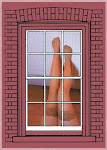
Nunca había visto al Real Ballet de Suecia. Fui solamente porque vi que interpretaban algo de Mats Ek. ¡Y qué sorpresa, el Ballet de Suecia fue excelente y por supuesto la coreografía de Ek tambien. Queda anotado en la lista de "mis bailes favoritos".
Rattika (rábano en sueco) es una interpretación coreográfica de la música de Brahms. Sin personajes, ni trama. Los bailarines se movían como animalitos, o pajaritos, y a veces hasta parecían plantas. Sus movimientos en manada o en bandada, haciendo y deshaciendo las formaciones, eran maravillosos. Hubo dúos y tríos muy tiernos, y cuartetos entrañables. El vestuario, con una cuidadosa selección de colores, ayudó a crear un bucólico país imaginario. Mágico el efecto sobre el gran escenario, tan vacío y negro.
La otra pieza, Tableau Perdue, de Christian Spuck, con música de Mendelsohn, también fue excelente. En palabras de Spuck: "intenté crear una ilusión de ballet clásico, utilizando tutús de tul y zapatillas de puntas como referencia. Pero a veces las lineas puras del siglo XVIII se desmoronan". Todos iban vestidos de negro, con una variedad de estilos que iba desde el tutú (me encantaron las mangas largas) hasta modelos más modernos de pantalones con faldas; a veces una gorguera blanca rompía la austeridad, y aportaba la referencia a un traje de época. Aunque más sobrio que Rattika en cuanto a vestuario, la coreografía de Tableau Perdue fue muy dinámica, con muchas diagonales. El único decorado, aparte de unos paneles blancos, fueron unas sillas negras que los bailarines no paraban de mover.
¡Fue un regalo de noche!
I have never seen the Royal Ballet of Sweden and only went because I saw that they were doing something by Mats Ek. And what a surprise - the Ballet, Ek´s choreography was excellent of course! It’s now on the list of "My Favourite Dances"! Rattika (raddish in Swedish) is a choreographic interpretation of Brahms's music; there were no people, no plot. The dancers seemed to be fluffy animals or birds. I loved the way they moved in a pack or a flock and the way the formations formed and disintegrated. There were tender duos and trios and quartets, and sometimes they even seemed to be like plants moving in the wind. The effect of an imaginary wonderland was helped by the lovely clothes and the colour scheme was very carefully thought out. Danced on the big, empty black stage, the effect was magical! The other piece, "Tableau Perdue" by Christian Spuck with music by Mendelsohn, was also excellent. And to quote: ”... I tried to create an illusion of classical ballet using tutus and pointe shoes as a reference. Even though sometimes the 'pure lines' of the 18th century collapse...”. They were all dressed in black but with a variety of designs that went from tutus (I loved the long sleeves) to more modern outfits with pants and skirts. The austerity was broken by the occasional white scarf or ruff that also hinted at period costume. Even though the effect was much starker than “Rattika”, the choreography was very dynamic, with lots of diagonals formed not only by the dancers but by the black chairs continually being moved about - the only props besides two white panels. What a treat of a night!



1 comentario:
It must have been amazing if you liked it, Diana; your standards are high. I wonder which specific pieces by Brahms were used . . . (of course, I'm a musician and can't dance.)
Publicar un comentario